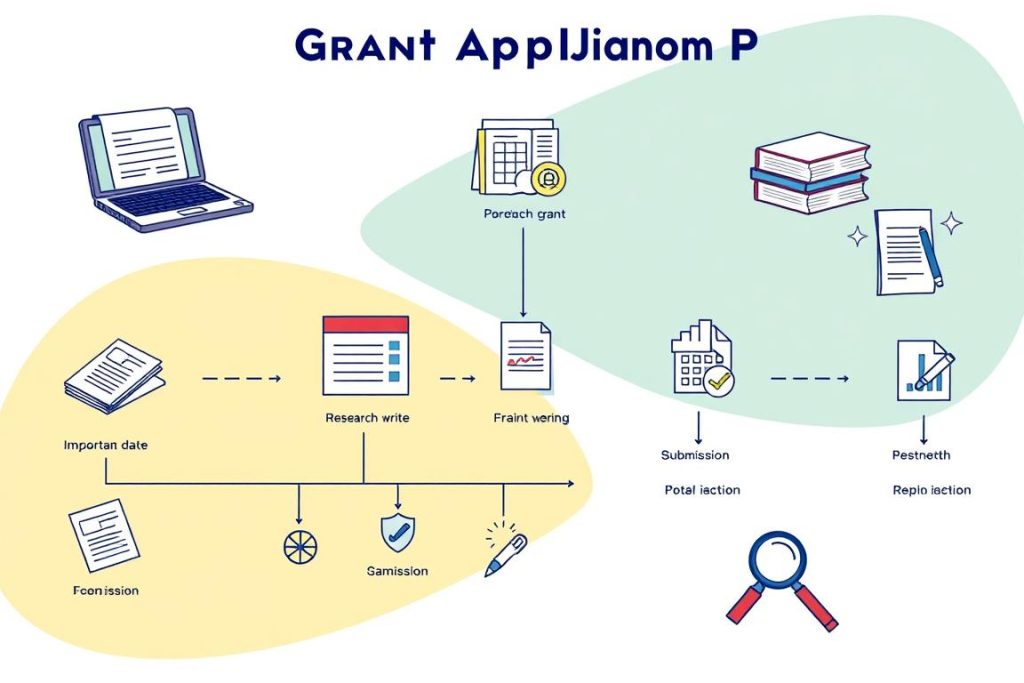With college fees skyrocketing, educational grants shine as a beacon of hope. Sarah, filled with dreams, looked at her dream university, hesitant because of the cost. Through her grant search, she found many options to help fund her education. Grants light the way to affordable education, offering financial ease. Federal and state programs help students like Sarah sail smoothly towards their goals without debt.
Your story could mirror Sarah’s with aid from programs like Federal Pell Grants1, TEACH Grants1, and Federal Supplemental Education Opportunity Grants (FSEOG)1. For military families, there are special grants to help with education costs. The Fulbright Program even offers chances for studying abroad, opening doors to global knowledge1.
Finding the right financial aid can be tricky. Pell Grants are crucial for those needing financial help2. State grants provide more localized support, and scholarships reward academic success2. The key to unlocking these opportunities is filling out the FAFSA, which makes you eligible for various awards2.
Key Takeaways
- Grasp the life-changing potential of grants on reducing education costs and increasing access to higher education.
- Understand the varying types of aid such as need-based grants, merit scholarships, and service-specific grants.
- Recognize that successful grant application processes start with completing the FAFSA and harnessing state and federal opportunities.
- Validate that comprehensive research and application endeavors can pay off in securing funds that do not require repayment.
- Consider the multifaceted benefits of grant opportunities, from lowering debt to fostering academic and professional growth.
Understanding Different Types of Educational Grants
Looking into different educational grants can help you a lot with college costs. We will look at many sources of grants, each designed for various needs and goals.
Federal and State Grants: Unlocking Opportunities for College Funding
Federal financial help and state grants make college possible for many. For example, the Pell Grant helps over 7 million students every year, giving out close to $30 billion. This helps students who really need it3. State programs, like California’s Cal Grants, help locals going to public and some private schools3. These grants look at your financial need and other things like where you live or what you study. It’s key to know about these requirements to get as much help as you can.
Grants for Specialized Fields and Public Service
There are special grants for needed careers and public service jobs. The TEACH Grant gives up to $4,000 a year if you agree to teach in important subjects for four years34. Programs that forgive loans for public service workers aim to reduce their college debt. This shows how important these jobs are to our society.
Programs for Undergraduate and Graduate Education in High-Need Areas
There are specific grants for important study areas for both college and grad students. The Federal Supplemental Educational Opportunity Grant helps undergrads who really need money, adding to what Pell Grants offer34. For healthcare workers, programs like one in Pennsylvania give out big grants. This highlights how crucial these healthcare workers are in places with not enough healthcare services.
To know your way around educational grants, you need to understand the requirements well. You can check out the Texas Education Agency’s website for more info on grants and how to apply here5.
| Grant Type | Eligibility | Award Amount |
|---|---|---|
| Pell Grant | Undergraduates with financial need | Varies, up to $6,4953 |
| TEACH Grant | Students in teaching, committing to 4 years in high-need areas | Up to $4,0004 |
| California Cal Grants | Residents attending eligible schools | Award varies based on school and need3 |
Getting to know these different grants can really help reduce your college costs. It lets you focus more on your studies and future career.
The Grant Application Process: A Step-by-Step Guide
Seeking federal funding or local grants requires knowing the grant funding process. The world of grants is vast with over 17,000 options and 150 new ones each week. It’s a realm full of opportunities yet highly competitive6.

Start by learning the grant application guidelines. Important details like who can apply, what documents you need, and how to submit are included. Not following these rules or missing deadlines could knock you out of the race early6.
Building a strong bond with grantmakers helps a lot. When your project matches their goals, your application stands out. This tactic shows you care about the same things they do7.
| Phase of Application | Key Activities | Expected Timeline |
|---|---|---|
| Initial Research and Alignment | Identifying matching grants, understanding eligibility, and aligning with grantor’s values | 1-4 weeks |
| Proposal Development | Developing the proposal, budget planning, and preparing supporting documents | 2-8 weeks |
| Submission and Follow-up | Submitting the proposal, ensuring adherence to guidelines, and follow-up communications | Depends on grant body (1 week to 12 months for decision) |
Good grant proposal strategies go further than just the application. They include detailed plans for the project’s future after the grant ends. Having a solid budget plan and clear goals is crucial for both approval and success7.
Applying for grants is complex and takes many steps. Fully understanding the grant funding process and staying in touch with grantmakers boosts your chances. It also opens doors for more opportunities later on67.
Maximizing Your Chances for Grant Approval
Finding the right funding can make your dreams come true. To win in the funding world requires knowing what leads to a successful application. Remember, winning proposals are more than asks for money; they’re strategic plans that fit the funder’s goals, showing the promise of your project8.
Essential Grant Writing Tips and Common Mistakes to Avoid
Your goal is to write a grant that grabs the funder’s attention by aligning with their objectives. A successful proposal is clear and relevant, showing how the funds will meet common goals8. Before you submit, review your proposal carefully. Make sure you’ve covered everything, avoiding mistakes that could set you back. Last year, by doing this, Millionaire Grant Lady and Associates secured over $1 million in funds for their clients9.
Navigating Deadlines and Eligibility Criteria for Successful Funding
Being on time and meeting eligibility are key to success. Federal grants often give you 6 to 8 weeks to apply after they announce it9. Take the TEACH Grant, for instance; it has strict criteria, including grade and service commitments. Miss the deadline and you miss out, so mark your calendar, get ready early, and apply, especially if they offer several awards9.
Strategies for Crafting a Winning Grant Proposal
To shine among the rest, your proposal needs to be timely and convincing. Spend 150 to 300 hours creating a story that showcases your project’s innovation and its fit with the funders’ goals9. If you can, add match funding to show your commitment. This move matches well with many grants’ requirements9. After you get the grant, be ready for detailed reporting to keep your project on track. Doing a thorough evaluation afterwards can show your project’s impact, boosting your organization’s chances for more funds in the future8.
For more on strategic grant planning and how to fully leverage federal grants, check out this detailed guide here.
FAQ
Federal and State Grants: Unlocking Opportunities for College Funding
Grants for Specialized Fields and Public Service
Programs for Undergraduate and Graduate Education in High-Need Areas
Essential Grant Writing Tips and Common Mistakes to Avoid
Navigating Deadlines and Eligibility Criteria for Successful Funding
Strategies for Crafting a Winning Grant Proposal
What are the key elements of a successful educational grant application?
How can I find out if I am eligible for educational grants?
Can I apply for educational grants every year?
What is the deadline for submitting educational grant applications?
How do needs-based grants differ from merit-based grants?
Are there grants available for graduate students?
What should I do if my financial circumstances change after I’ve submitted my grant application?
Source Links
- Grants for College – https://www.salliemae.com/college-planning/financial-aid/understand-college-grants/
- The Basics on Grants and Scholarships – BigFuture – https://bigfuture.collegeboard.org/pay-for-college/get-help-paying-for-college/scholarships-grants-institutional-aid/the-basics-on-grants-and-scholarships
- What Is a Grant for College? | BestColleges – https://www.bestcolleges.com/blog/what-is-college-grant/
- What Are Grants for College? – https://www.franklin.edu/blog/what-are-grants-for-college
- A Beginners Guide To The 4 Types Of Federal Grant Funding | AmpliFund – https://www.amplifund.com/learning-hub/resources/articles/4-types-of-federal-grant-funding/
- Grant Application Guidelines: A Comprehensive Guide for 2024 – https://www.instrumentl.com/blog/grant-application-guidelines
- 14. Applying for Grants | Community Tool Box – https://ctb.ku.edu/en/applying-for-grants
- Maximizing Your Grant Funding: Effective Strategies – https://nonprofitplus.net/maximizing-your-grant-funding-effective-strategies-for-nonprofit-organizations/
- 5 Tips to Evaluate Federal Grants and Maximize Your Success – https://millionairegrantlady.com/navigating-federal-grants-5-tips-to-help-you-evaluate-federal-grant-opportunities-and-maximize-your-chances-of-success/

